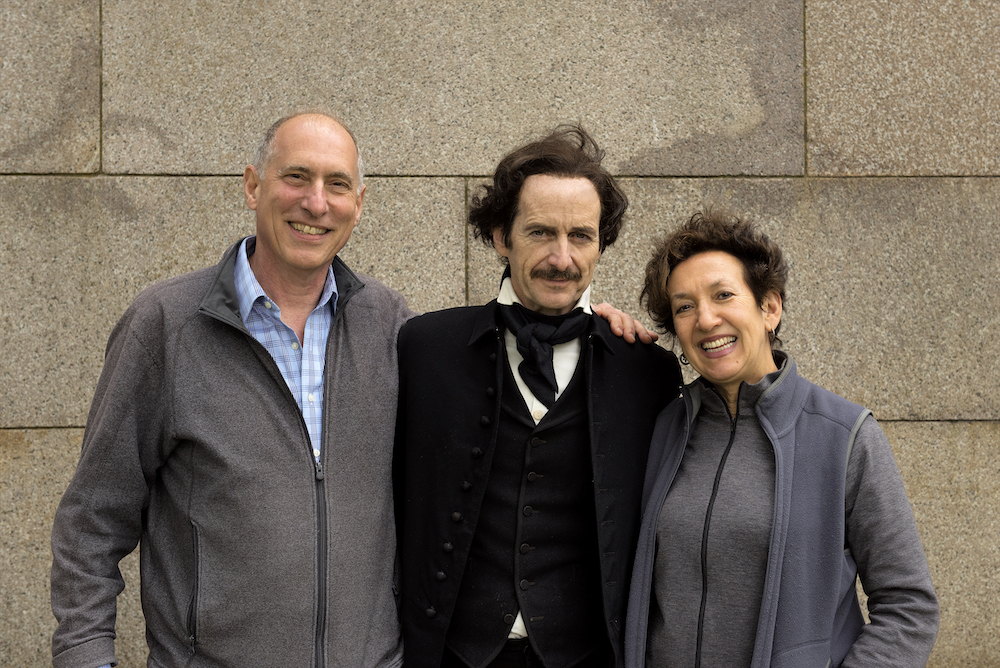
With Poe's Dupin stories, he found a way to satisfy the reading public’s appetite with stories that were sensational and entertaining, but that also project a comforting sense of safety with a father-like figure who imposes order on chaos.
Pictured: American Masters Edgar Allan Poe: Buried Alive writer/director Eric Stange, Tony Award-winning actor Denis O'Hare, and pre-production coordinator Barbara Costa. Photo credit: Liane Brandon
I grew up in a family of mystery writers. Both my grandfather and my mother published in Ellery Queen’s Mystery Magazine, so the glossy digest held a reverential place in our home. We were of course mystery readers too. Our bathroom was likely to have one or two half-read Erle Stanley Gardners, and Nero Wolfe sat on the breakfast table. I remember my grandfather telling me about the prestigious Edgar Awards. I knew they were named for Edgar Allan Poe, but I don’t think I knew the reason why. I hadn’t absorbed–until recently–the fact that it was Poe who invented the genre of the detective story.
While making my film, Edgar Allan Poe: Buried Alive (premiering on the PBS series “American Masters, and available on DVD from PBS Distribution), we go into some detail about how Poe created the conventions of modern detective fiction. He wrote only three “tales of ratiocination,” as he called them, but in his central character, C. Auguste Dupin–the brilliant and eccentric intellect who solves crimes despite the inability of the police to understand the evidence–Poe formed out of whole cloth the detective we’ve been living with ever since.
Virtually every convention of detective fiction is present in Poe’s three Dupin stories of the early 1840s–though the word “detective” hadn’t even been coined yet. The central character, of course; the first-person narrator who’s the detective’s admiring side-kick (and a stand-in for the reader); the bumbling police detective; the false leads; and the denouement in which the detective unravels the dazzling skein of logic that led him to the inevitable conclusion.
But what, I wondered, led Poe to this unprecedented character and plot construction? Zach Dundas, author of The Great Detective: The Amazing Rise and Immortal Life of Sherlock Holmes, offers some thoughtful insights in our film. The 1830s and ’40s, the onset of the industrial revolution, was a period of enormous upheaval in the United States. Among the many changes, new printing technologies, higher literacy rates, and transportation webs helped create a vast new market of readers; the era of mass media was upon us.
At the same time, it was an unsettled and anxious period. Cities exploded with rural refugees and foreign immigrants, crime was on the rise, epidemics frequently swept through crowded slums, and economic downturns led to a sense of almost permanent instability. One result of the cultural turmoil was a reading public that craved reassurance in the form of narratives in which reason and logic overcame disorder and violence.
Poe’s precarious livelihood depended on a finely tuned sense of what readers demanded. With the Dupin stories he found a way to satisfy the reading public’s appetite. “The Murders in The Rue Morgue,” “The Mystery of Marie Roget,” and “The Purloined Letter” are short stories that are at once sensational and entertaining (like many Poe stories, sexual innuendo lies not far beneath the surface), but that also project a comforting sense of safety with a father-like figure who imposes order on chaos.
It’s one of many sad facts of Poe’s life that when he died in 1849 at age 40 he had no idea what his Parisian detective would spawn. As Arthur Conan Doyle–perhaps the greatest beneficiary of Poe’s creation–said in 1909 Poe centenary celebration, “Where was the detective story until Poe breathed the breath of life into it?”
Written and directed by Eric Stange, the new documentary American Masters – Edgar Allan Poe: Buried Alive explores the misrepresentations of Poe as a drug-addled madman akin to the narrators of his horror stories. It stars Tony Award-winning and Emmy-nominated actor Denis O’Hare (This Is Us, American Horror Story) with narration by Oscar- and Tony-nominated, two-time Golden Globe-winner Kathleen Turner, and premieres nationwide Monday, October 30, 2017 at 9 pm on PBS (check local listings) and is available to stream Halloween via pbs.org/americanmasters and PBS OTT apps.


